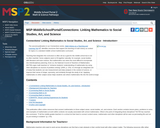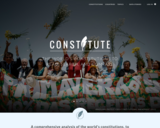
This document discusses the different types of assessment in Physical Education and how to assess each learning domain.
- Provider:
- SHAPE America
- Date Added:
- 07/18/2023

This document discusses the different types of assessment in Physical Education and how to assess each learning domain.

This article describes six collaborative and real data projects that engage elementary students in collecting and sharing local data and communicating with students across the country and world.

In this episode of UEN's PDTV Principals Edition, we meet Teacher Leader and Administrator Elizabeth Julian at Boulder Elementary. Elizabeth has transformed her school into a place of innovative learning with the support of incredible partners like the Utah Film Center, Utah Education Network, and SEDC. These partnerships have brought exciting and enriching experiences directly to her students. We'll get a glimpse into just how these partnerships have made a difference at Boulder Elementary.

Students see that geometric transformations—dilation and translation—correspond to algebraic parameters—m and b—in the familiar equation for a linear function.

In this unit, students become active archivists, gathering photos, artifacts, and stories for a museum exhibit that highlights one decade in their school's history.

The purpose of this practice is to allow students to showcase their understanding of how Neurons share information inside the brain to allow for the mind to grow with knowledge. The student product will be a student poster made by table groups.

The purpose of this "lesson" is to instruct students how to properly connect thier iPads and install apps to the iPad. ISTE Standard 1.1 Empowered Learner 1.1d - Students understand the fundamental concepts of technology operations, demonstrate the ability to choose, use and troubleshoot current technologies and are able to transfer their knowledge to explore emerging technologies. Photo: Ipad.jpeg. Wikimedia. 2018
Students will learn about their own heritage by filling in an outline and then creating a poster.

This publication offers online resources that connect mathematics to three subject areas: social studies, art, and science. Each section contains lesson plans, problems to solve, and examples of mathematics at work within contexts not usually associated with school mathematics.

This article describes online artifact collections available through the Arctic Studies Center, a part of the Smithsonian's National Museum of Natural History. The collection includes artifacts and background information about the peoples of Alaska and Northeast Siberia.

This is guidance on AI from Conneticut.

The purpose of this task is to have students think about the meaning of multiplying a number by a fraction, and to use this understanding of fraction multiplication to make sense of the commutative property of multiplication in the case of fractions.

Students explore the connotations of the colors associated with the characters in F. Scott Fitzgerald's "The Great Gatsby."

This article from the free online magazine Beyond Weather and the Water Cycle provides appropriate science lessons for Grades K-5. The focus is on acquainting young learners with climate-change concepts that are not too complex for their grade level and will not frighten them. In each issue, the magazine develops articles around one of the seven essential principles of climate science. The author believes early lessons about water availability and extreme weather events will prepare students for complex climate concepts they will encounter in later grades.

Students will predict possible consequences of substance use and analyze how social messages regarding the use of alcohol, tobacco/nicotine and other drugs may misrepresent the negative effects of each.

Students can se;lect to learn about conservation of momentum by using either the PhET Collisions Lab or The Physics Classroom Exploding Carts simulations. Students are also introduced t o spreadsheet formulas and graphs using Google Sheets.

Implementing literacy coaching is a complex process that includes several areas for consideration. District and school-level administrators, coaches, and teachers may be unaware of what they can do to help ensure coaches are as effective as possible in their role. Presented in this infographic are four specific areas shown from the research to be important when planning for and implementing literacy coaching.

Students will create their own constellations. They will give it a name, design what it looks like, and write a backstory of how it came to be. This will be paired with Indigenous stories of constellations. Then, students use the Star Chart app to identify their own constellation and create a story that explains it. Students will use Flipgrid to create and share stories with a wider audience. Students can screen share with Flipgrid to show their constellation. Students can also import their constellations and other images into Flipgrid to have visuals as they narrate their story.

The text of the United States Constitution translated into Spanish. The page does have advertisements as well, so it is best used as a teacher resource.

The world's constitutions to read, search, and compare